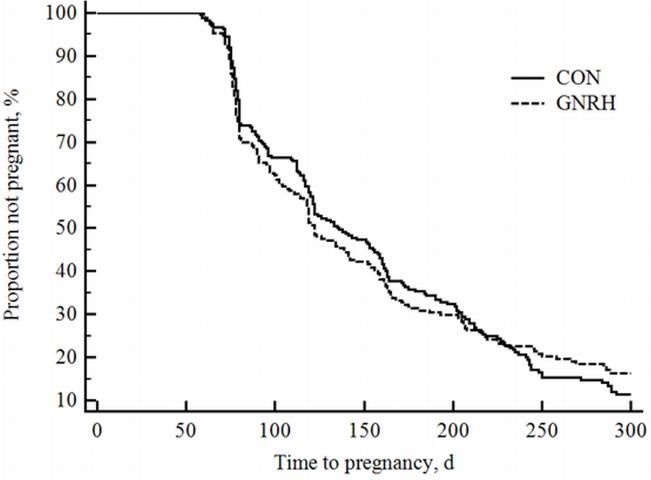Introduction
It is well established that early cyclicity results in increased pregnancy per artificial insemination (PAI) and decreased time to pregnancy (Thatcher and Wilcox 1973; Darwash et al. 1997; Galvão et al. 2010). Treatment with gonadotropin-releasing hormone (GnRH) has long been used to induce ovulation in early postpartum dairy cows (Britt et al. 1974). Earlier studies showed an improvement in ovulation risk from 20%–28% to 75%–90% when GnRH was administered between 10 and 14 days in milk (DIM) (Britt et al. 1974; Benmrad and Stevenson 1986). Effects of GnRH administration early postpartum on fertility, however, have not been consistent. Some studies showed a detrimental effect of GnRH administration early in lactation on uterine health and reproductive performance (Etherington et al. 1984; Stevenson and Call 1988; Padula and Macmillan 2002). Others failed to show an improvement in reproductive performance when GnRH was administered early in lactation (Cavestany and Foote 1985; Foote and Riek 1999). Nonetheless, others have reported increased PAI and reduced time to pregnancy (Nash et al. 1980; Benmrad and Stevenson 1986; Jeong et al. 2013) or reduced culling because of reproductive failure (Britt et al. 1977) when GnRH was administration between 8 and 29 DIM.
Nevertheless, none of the previous studies used synchronization programs such as the Presynch-Ovsynch as part of their reproductive management. Therefore, the objective of this article is to present the results of a recent paper (Bittar et al. 2014) that evaluated the effects of administration of GnRH at 17 ± 3 and 20 ± 3 DIM in Holstein dairy cows without a corpus luteum (CL) on induction of ovulation, uterine health, and reproductive outcomes.
Evaluation of the effect of GnRH administration in early lactation on induction of ovulation, uterine health, and reproductive outcomes
Holstein cows without a CL at 17 ± 3 DIM were assigned randomly to receive intramuscular (i.m.) GnRH (n = 245) at 17 ± 3 and 20 ± 3 DIM or to remain as controls (n = 245). Ovaries were scanned by ultrasonography (US) twice weekly totaling four examinations. Ovulation was characterized by the appearance of a CL = 20 mm at any US or by CL < 20 mm in two consecutive examinations. Clinical and cytological endometritis were diagnosed at 35 DIM. Compared with control, GnRH increased ovulation up to 3.5 d after the last treatment (78.7% vs. 45.0%), and did not affect the prevalence of clinical endometritis (23.9% vs. 18.6%) or cytological endometritis (30.9% vs. 32.8%). Treatment with GnRH did not affect pregnancy per AI at 32 d after AI (37.6% vs. 38.6%) or 74 d after AI (35.0% vs. 31.5%), but treatment with GnRH reduced pregnancy loss (6.8% vs. 18.1%). There was no overall effect of GnRH treatment on hazard of pregnancy (Figure 1).

Credit: Adapted from Bittar et al. (2014)
Conclusion
In summary, early postpartum administration of GnRH induced ovulation without affecting uterine health, but failed to improve PAI or time to pregnancy, although it reduced pregnancy loss.
References
Benmrad, M., and J. S. Stevenson. 1986. "Gonadotropin-releasing hormone and prostaglandin F2α for postpartum dairy cows: estrous, ovulation, and fertility traits." J Dairy Sci 69: 800–811.
Bittar JH, Pinedo PJ, Risco CA, Santos JE, Thatcher WW, Hencken KE, Croyle S, Gobikrushanth M, Barbosa CC, Vieira-Neto A, Galvão KN. 2014. "Inducing ovulation early postpartum influences uterine health and fertility in dairy cows." J Dairy Sci 97: 3558–69.
Britt, J. H., D. S. Harrison, and D. A. Morrow. 1977. "Frequency of ovarian follicular cysts, reasons for culling, and fertility in Holstein-Friesian cows given gonadotropin-releasing hormone at two weeks after parturition." Am J Vet Res 38: 749–751.
Britt, J. H., R. J. Kittok, and D. S. Harrison. 1974. "Ovulation, estrus and endocrine response after GnRH in early postpartum cows." J Anim Sci 39: 915–919.
Cavestany, D. and R. H. Foote. 1985. "Reproductive performance of Holstein cows administered GnRH analog HOE 766 (Buserelin) 26 to 34 d postpartum." J Anim Sci 61: 224–233.
Darwash, A. O., G. E. Lamming, and J. A. Wooliams. 1997. "The phenotypic association between the interval to postpartum ovulation and traditional measures of fertility in dairy cattle." J Anim Sci 65: 9–16.
Etherington, W.G., W. T. K. Bosu, S. W. Martin, J. F. Cote, P. A. Doig, and K. E. Leslie. 1984. "Reproductive performance in dairy cows following postpartum treatment with gonadotrophin releasing hormone and/or prostaglandin: a field trial." Can J Comp Med 48: 245–250.
Foote, R. H., and P. M. Riek. 1999. "Gonadotropin-releasing hormone improves reproductive performance of dairy cows with slow involution of the reproductive tract." J Anim Sci 77: 12–16.
Galvão, K. N., M. Frajblat, W. R. Butler, S. B. Brittin, C. L. Guard, and R. O. Gilbert . 2010. "Effect of early postpartum ovulation on fertility in dairy cows." Reprod Dom Anim 45: e207–e211.
Nash, J. G., L. Ball, and J. D. Olson. 1980. "Effects on reproductive performance of administration of GnRH to early postpartum dairy cows." J Anim Sci 50: 1017–1021.
Padula, A. M., and K. L. Macmillan. 2002. "Reproductive responses of early postpartum dairy cattle to continuous treatment with a GnRH agonist (deslorelin) for 28 d to delay the resumption of ovulation." Anim Reprod Sci 70: 23–36.
Stevenson, J. S., and E. P. Call. 1988. "Fertility of postpartum dairy cows after administration of gonadotropin-releasing hormone and prostaglandin F2α: a field trial." J Dairy Sci 71: 1926–1933.
Thatcher, W. W., and C. J. Wilcox. 1973. "Influence of early estrus, ovulation, and insemination on fertility in postpartum Holstein cows." J Dairy Sci 56: 608–610.